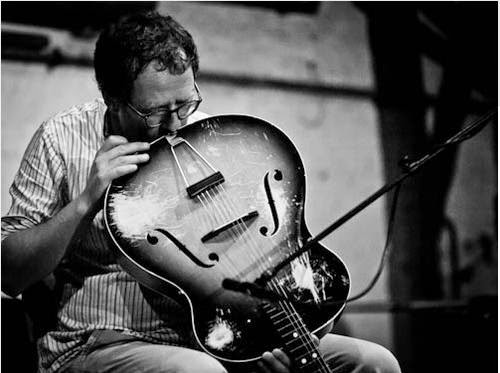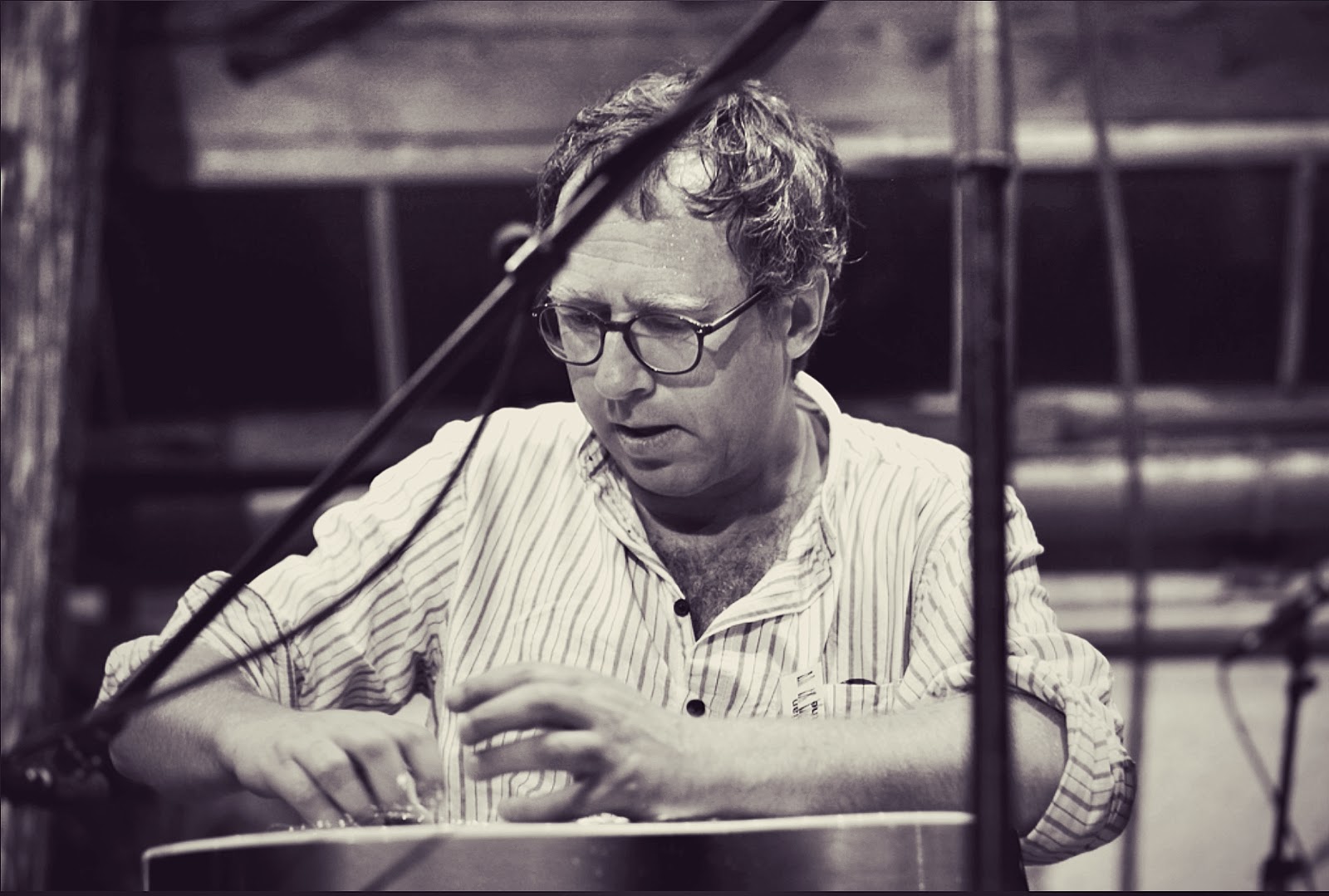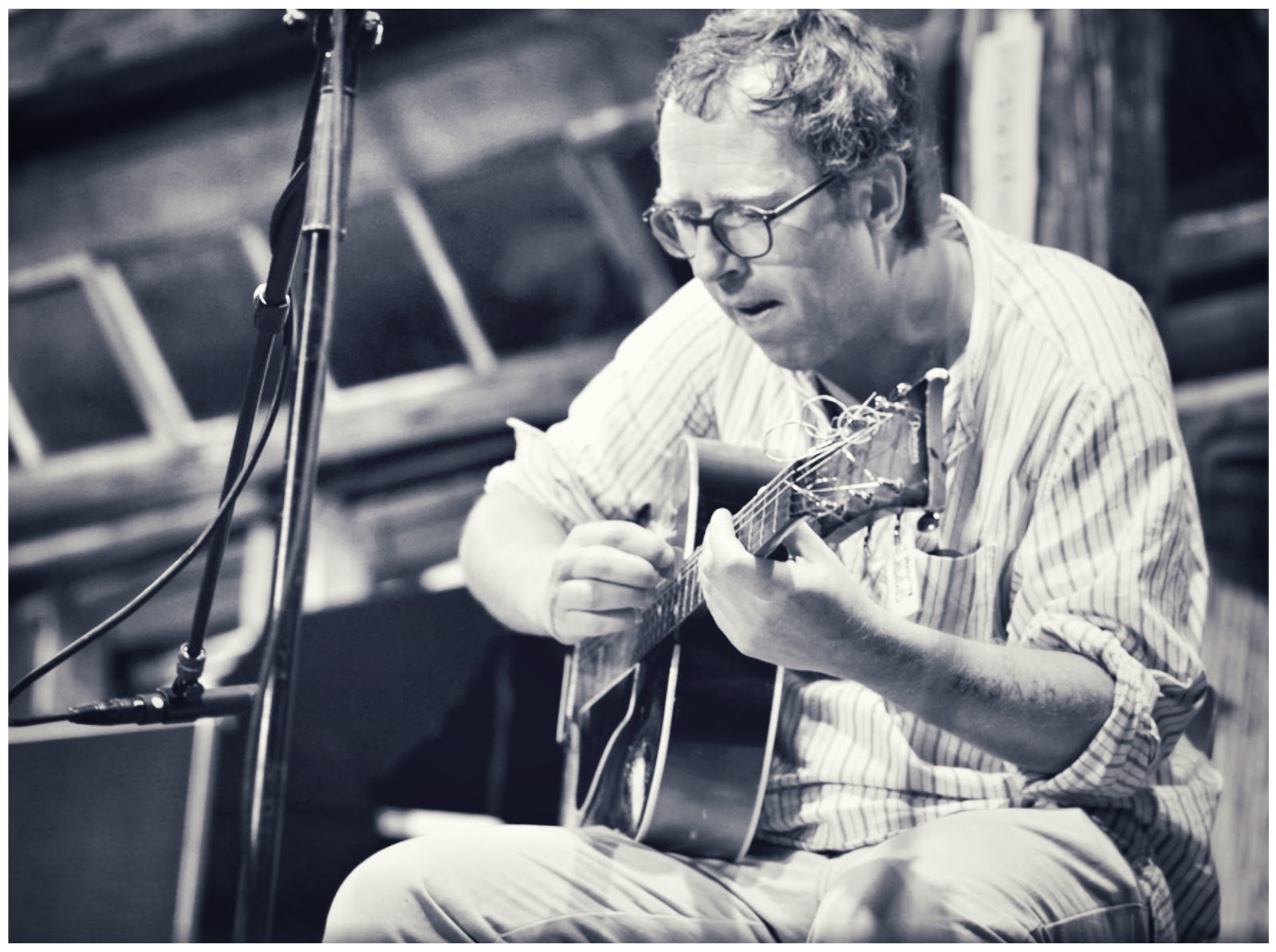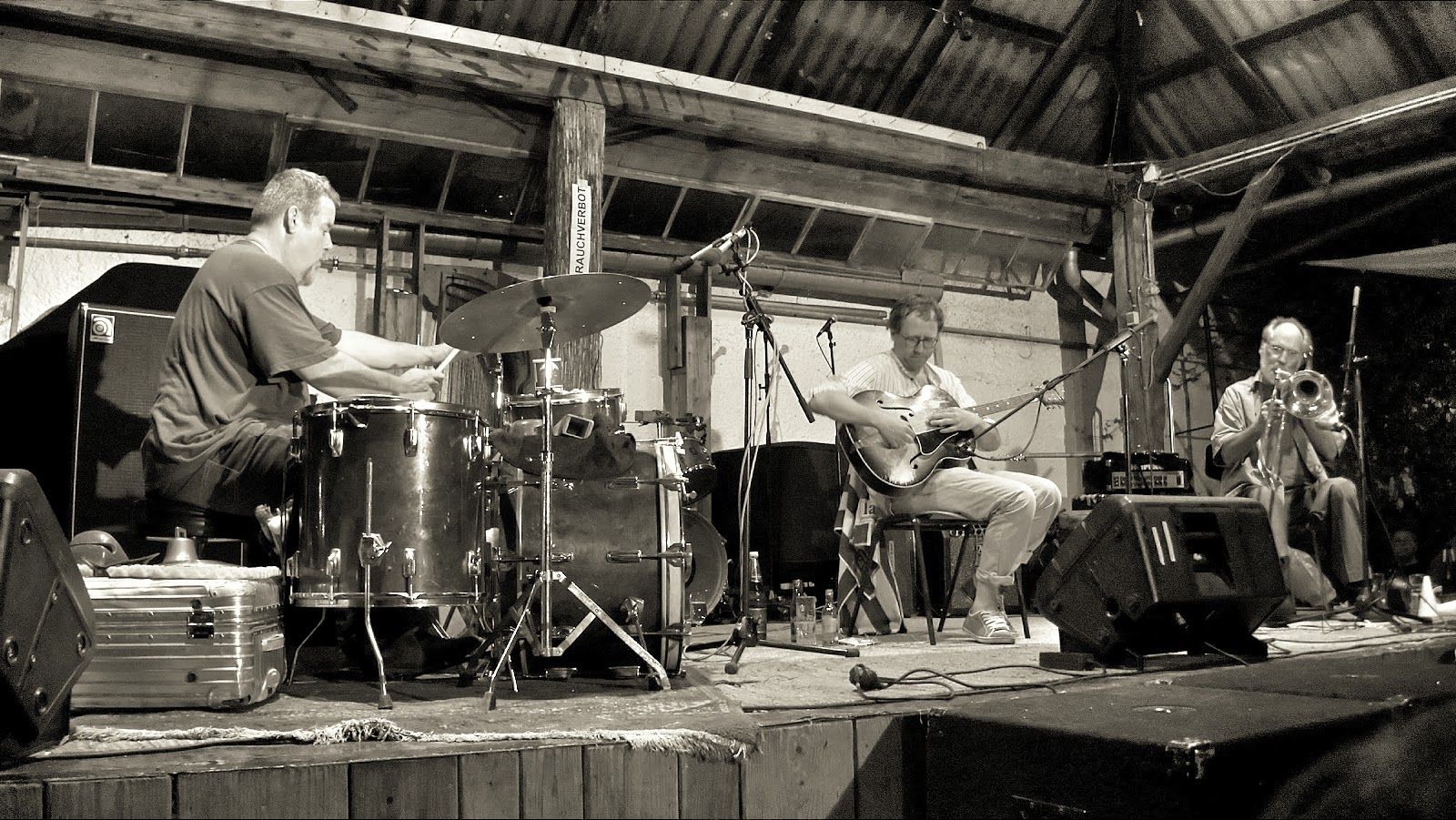
Christian Munthe was born in 1962, Sweden, where he still lives, and has played free improvised and experimental music on guitar since the mid 1980's. His first recording being two tracks with a duo with Mats Gustafsson, Two Slices of Electric/Acoustic Car, on the double vinyl album SOUNDS, he has since then played and/or recorded with a large number of Swedish and international figures in free improvised and experimental music, among these Raymond Strid, Günter Christmann, Nina de Heney, Paul Lovens, Anders Dahl, Roger Turner, Thomas Lehn, Phil Minton, Christine Abdelnour, Ida Lundén, Philipp Wachsmann, John Russell, Patrick Farmer and Tatsuya Nakatani. He is not a professional musician or artist, but works as professor of philosophy at the University of Gothenburg.

Photo Peter Gannushkin
To make make this Q & A psychologically possible, Christian took upon himself to divide himself into an interviewer and interviewee. He does like to talk, doesn't he?

Photo Peter Gannushkin
Your first own guitar, what was it?
A Polish/Czech/Soviet made semi-acoustic hollow-body, bought in Warzaw in the mid 1970's by my maternal grandmother who lived there, when I was around 11-12. Not unlike this one, although I've forgotten the actual brand:

Terrible action, even worse mechanics and horrible eastern Europe single coil mikes – but it worked and toughened my basic chops :-). I ran it through my mother's old reel to reel tape recorder as amplifier and speaker, where there was a soundback function that you could use for amplification if you pressed recording and pause. Made for a nice, soft valve distortion when you cranked all the controls up to max.
So you had a musical home, I gather?
Not really, that tape recorder was used for theater. There was no music to speak of except what happened to come out of the radio and none of my parents played or sang in any organised way. Neither did people around us, except the kind of jolly singing people do when getting drunk or having agood time otherwise. We didn't really have a record player until I was 10-11 something, and I got my first records just before that. But both me and my sister got into music early (she went on to take an academy degree as a soloist on recorder for baroque music and also sings very well). My first memory of music that really moved me was Muddy Waters on TV in the late 1960's or early -70's doing Mannish Boy, I caught that by pure accident.

Photo Peter Gannushkin
Almost immediately, however, I was less interested in playing than making my own music, and being good at my instrument never occurred to me as being of particular importance. And I always felt very free also with ready-made songs by others; to do them as I wanted, learn them on feeling rather than note for note, change them around, etc. My father had this way of humming and singing traditional and popular tunes all the time, changing them around, mixing them, making up silly lyrics on the spot, as he went on doing stuff at home and in the garden. Sometimes, I think my core relationship to music is based on that. This is why, nowadays, I believe, I so much love to hear young people having this sort of attitude also outside of improvised music. The Finnish band The Silver's version of Do You Wanna Dance is a perfect example – not a note right, but up there with the best rock performances ever:
But, of course, most of what Derek Bailey's done possess that sort of quality as well. That off-hand feel, like a domestic day-to-day conversation of sorts that attains the quality of superb art. Derek's also quite a technical guitar player, of course, but that's not where I've been inspired by his works, really. If you know guitar and hear us, you can tell how little I've adapted of his technique. Style-wise, sure – like the mixing in of harmonics and regular notes within the same sequence, that stuff – but not technically.

Photo Bogdan Dimitriu
Yea, I think so, as being an improviser is so much about basic temperament and stance and so little about technique. I had a tough patch in my life some years back and took some therapy as support, and one thing we sometimes talked about, me and the therapist, was what kind of posture towards life is expressed by the act of improvising, and when I told him about my music and how I and others approach it, he said one thing that shocked me a bit at the time but later made lots of sense: ”So you die every time”, he told me, implying that this was a courageous thing; but I never felt courageous as I never felt any fear to begin with of jumping into the void of improvising – but jumping into it and dying is what it's about – that's why you feel so alive by doing it, is my hunch. Still, I didn't really get into improvisation of any kind until my late teens, when the pop/rock band I played in started to move into more jazz-rock/fusion kind of territory.
Mats Gustafsson + Christian Munthe play the Sinking Ship in Vancouver, Feb 8/09.
Before that I had mainly been into composition, arranging and songwriting – I was the vocalist and rhythm guitarist and main song writer, although we did lots of things collectively as you do in a band, the other guitarist was the one who could really play. So this forced me to practice the guitar as a solo instrument, but also to develop my composing in parallel, also in that way developing my relationship with the guitar as a tool for handicraft. Gradually, I found I liked it better when we jammed than when we played our set tunes, and I also started to discover lots of new music in the jazz direction, being mostly interested in the interaction and non-predictable aspects of what went on. At the end of this period (around 1985), I had developed my skill as a pretty ”free” player, but still locked into conventional frames of twelve notes, harmony (including disharmony) and so on as you normally relate to it in jazz, and it was around this time that I met Mats Gustafsson and we started to discover lots of shit together, among this the more ”pure” and sound-oriented improvised music from Germany and the UK. Mats, as you know, is and was also then very much into high energy free jazz and the extension of that with Brötzmann, etc. I didn't dislike that (and I still do love especially Cecil Taylor and some of the late Coltrane things, for instance), but it never really influenced me as a player (except perhaps Cecil's stuff – where the density of the interplay is more primary than the raw power).
What did influence me was the kind of free improvised music where the energy was in the interaction, speed, fluidity and density rather than decibels, breathlessness and muscular power. This was the thing that developed in parallel in the UK – I couldn't believe it when I heard London Concert with Derek and Evan for the first time; that level of listening and interaction. Then I discovered this was a thing going on between several others in the UK especially, but also in Germany, emanating out of Günter Christmann's ideas and works from the 1980's, Sven Åke Johansson as well; and in Sweden at this time there was a revival of free improvised music partly inspired by such aspects, which I was lucky being close to, as it unfolded around Fylkingen and the legendary ANDRA record shop in Stockhom in the late 1980's and early 90's, with people as Mats, Sten Sandell, Raymond Strid and some others – and Harald Hult, who ran that shop and also put on concerts. There's so much to say about this period, I learnt so much about music, and I ended up going over to acoustic guitar; the one which I eventually used on my first record, Muntmunt (produced by Harald and recorded in his shop), of the improbable brand ”Cyclop”:
Here's a track from this record I still like; a duo with Phil Minton, recorded at a concert at the ANDRA shop in the early 90's:
Here's me with it around this time:
Do you still use it?
No, actually it broke apart around this time too. It was a cheap, really bad guitar in all respects – and old and not taken care of very well. A small steel string, of the kind the salvation army people used use in the streets, but not of any of the better brands, like Levin, of which you can still find good instruments. I bought it via an ad by an old man who had won it on a lottery when he was in the miltary in the 1940's. I played it acoustically and, as you can hear a little bit on the track with Phil, with a contact mike attached, running through a volume pedal. Eventually I started using some electronics as well, mixing with the acoustic sound. But mainly it was the rather dead timbre of the acoustic sound I was after at the time. I wanted something percussive, as this was the direction my playing was going; viewing the guitar more and more as a pecussion instrument. Also I wanted a guitar that did the opposite acoustically of what you normally want a guitar to do; rather than having the main tone in the forefront and the natural harmonics around it pushed back, I wanted the harmonics on as much of an equal footing. Basically, I wanted the strings to function acoustically and tonally as cymbals, I think. At the time it was all very inuitive. Anyhow, the percussion development also led me to use the entire body as a sounding surface, and unforunately this guitar was not up to that. You can see how it's backside has cracked badly already in the CD cover above, but now it just fell apart. The last gigs I used it it held together with guitarstrings wrapped around it and gaffa adhesive tape – now it hangs on the wall in my office at the university.

Photo Jonas Ahrentorp
So the guitar you use now, is that a better one?
Not really, it is more sturdy, though. I found it in a second hand shop in Gothenburg, by then I knew I didn't want a pricy instrument, since my way of playing had become increasingly physical. Wouldn't have the heart to treat an old Gibson or Epiphone like that. So this one's of the brand ”Ramona”. Basically it's a copy of a Gibson or the Swedish Levin style of f-hole acoustic, arch-top steel string guitar to use with a big band or an orchestra to play dance music of the 1940's or 50's. It's made for strumming and to be heard, and it's very heavy duty – it'll hold together until my scrapings drill too many holes in it. It's also larger and louder than the old one, but the acoustics are the same – if not more; especially the percussive quality is wicked. So, I started using it mid 1990's, still with the amplification set-up described earlier. But then I had a pause from music since I had to concentrate on my university work and be a father to my daughter who appeared in 2000, and when I came back to playing again in 2005, I discovered I didn't want the electronics or the amplification anymore – it had started to impede sonic possibilities rather than enhance them. I did miss the volume pedal for a short while, but not for long. This instrument has seen me through the things I started to work on after that, inspired by all the new things I was exposed to when returning to music. A very important inspiration was meeting Anders Dahl – we eventually made a record – Several Kinds of Ground, Tyyfus label– and we have a new one with a trio with Patrick Farmer coming out just now on BOMBAXBOMBAX, Rhino.
Here's that trio live in 2011:
Here's me with that guitar doing a solo thing in a small gallery in 2012:
And here's a duo with Christine Abdelnour in London from the year before; we also released a duo CD, Yardangs:
Your music's moved along from the, let us say, more ”traditional” impro you were originally inspired by then?
Yes, I would say so. Not that I dislike it, here's a piece I did with Günter Christmann and Raymond Strid in 2010 at the Nickelsdorf Konfrontationen festival, which is very much in that vein, although I do use some of the approaches developed in later years as well:
But basically, you're right, although it's a gradual thing. I've never been a purist and I never felt I had to do a clean slate, proclaiming myself a reductionist or anything like that. I do feel more and more drawn to finding new types of sonic interaction that changes entirely my concept of relating to what I'm after in playing, though. Me and Anders worked very much to find a sonic voice together, starting with the idea of merging the purely acoustic and the purely electronic into a single alloy. We did at least two recordings before we had one we wanted to release and in between a number of gigs before we started to find what we wanted – although we connected instantly as improvisers in that way you do with certain people, as me and Mats once did.
Christian Munthe Guitar & Bon Tan Sui (Japan): Image & Video.
Before, I would have thought in terms of developing a language together, but now I started to think in terms of a voice or a sometimes rigid, sometimes shifting body. This is significant, I think, it signals that I've started to model the qualities I seek in an improvisation by myself differently. It's less of a thing that travels through time nowadays and thus, the analogy with a conversation is less appropriate than it used to be. This became even more obvious in two solo works I did in this time, The Backside Suite and Blowing the Wind. These were the first real ”projects” I've ever done, based on concentrating entirely on one unorthodox technique at a time; using only the backside of the guitar as a soundboard, and using the guitar as a wind instrument. Here's a sample of the backside playing from a live situation:
To the BTW, I also made a bunch of videos, helped by a Japanese artist Bon Tan Sui, this is one of them:
But at the same time, during this time, I also reconnected myself to diatonic harmony and traditional forms I had always felt affinity for, like the blues and hillbilly style early american folk. I found I was now mature enough to incorporate them just as any other part of my approach. So I made a record based on that called 12 Songs. Here's a live performance from Oslo (a shared thing with John Russell and Ketik Gutvik a few years back) very much coming out of that:
So where does that leave you right now?
I'm actually not sure. I'm releasing a few records – the trio with Dahl and Farmer I mentioned, and a just released duo with reed player Johan Arrias on Bug Incision, Torso and Legs, and an as yet unnamed duo with Patrick Farmer on the same label. But all of these recordings are from 2011. This is due to me suffering some illness in 2012, and still recuperating and getting back into university work in 2013 and -14, and having just started to feel energy for music coming back. The only thing I have going on at the moment is an as yet rather secret compositional project together with Anders Dahl. We've barely started though, but the working title is Message In A Bottle. I've also contributed to Anders next edition of his 12-tone concept piece Rows.

Photo Peter Gannushkin
Otherwise, I'm unsure where to go at the moment. The direction developed during the last few years has been enriching, but I start to feel that there's not much to be had there by going further; it will just be a repetition with minor variations. Perhaps, this thing with Anders will continue and I will get back into composing after all these years? But I've also thought of a number of versions of approaching a puristic return to old things: the electric guitar or melodic playing. Or both. Perhaps not even improvisational, but I'm not sure. We'll see. I do feel there's a lot of unexplored territory with the electric, if only you discipline yourself to avoid the most obvious and cheap solutions. I'm not thinking soundboard-approaches like that of Keith Rowe, rather the opposite: very orthodox starting point, but don't know yet where this line will bring me. In the meantime, I've done some completely different things to provoke myself, sort of EAM using sampling and field recording and processing, like this piece that was displayed at a concert in honour of Swedish EAM, sound poetry and performance pioneer, Sten Hansson:
This is a different way of handling a development than if you're a professional player?
Indeed, I believe it is. Partly, this situation forces me away from music in periods, as I have to support myself and I want to be a good person in my family life, but also has a lot of engagement for what I do at university. Then when I come back, things have changed – around me and inside me. Partly, it liberates me from the pressure of adapting my playing or music to something that can be transformed into making a living, ort to hold on to things just because they've become trademarks. I realised quite early on, in my teens, that my attitude to music and playing was not for a professional career. Now when I'm fifty plus and looking back on that decision, I think this was good intuition on my part. I've been freer in my artistic endeavours than I would otherwise have been. At the same time I've been blessed by a situation of having professional players I respect viewing me as an interesting collaborator from time to time.

Photo Bogdan Dimitriu
So, if you listen to guitar music now, what is it?
This is the thing. I don't listen so much to music at all anymore – I usually prefer silence. When I listen, I do it extremely concentrated, in bursts. At the same time, I can recall lots of music I like in my head – sort of play it that way. But ok, here's a rather traditional piece of playing I've been returning to several times since it was made available online – Scofield has been a favourite of mine among the contemporary jazz players since before he joined Miles, but now he has a maturity and simplicity that's about the purest there is this side of Jim Hall:
Otherwise I've been quite excited by Mary Halvorson:
She's completely different from me in so many ways, but I really feels an affinity for the way she works within a broadly conceived jazz concept – branching out into kind indie rock sometime– with structured improvisations and compositions. Also her way of relating to the guitar, that slightly angular feel to her touch, and biting attack; nice!
And I mustn't forget my classical buddies, The Gothenburg Combo; their latest release Guitarscapes is a landmark for others to relate to for a long time ahead.
So, let's ask about technique: how do you conceive of it, its importance, what it involves?
Being able to play what you aim for, basically. I've never been a virtuoso, not even close, I'm not the type. As I say, I'm more of a composer than a musician at heart. Although, I can enjoy a sparkling player like Alan Holdsworth or Hendrix, I tend to prefer players with more purified and moderated approaches. David Gilmour has been a hero since my early teens, if I'm to play a bluesy solo in some hobby band setting, this is my ideal. But others more close to what I've done myself would be Jim Hall, as I mentioned, and Robert Fripp, or Bill Frisell – they all have a refined and slightly intellectualistic quality I like – smart, if you like – without lack of emotion. They are technical in a certain sense – they are disciplined – but they are as far from blazing as anything. But that's where I am, I don't really do blazing, I'd rather have Tommy Iommi or Neil Young for a solo than Steve Vai. Looking at more experimental and free impro stuff, I don't really care about instrumental technical versatility either. I know that certain players have a lot of it, and I enjoy many of them – Evan Parker being an obvious case in point. But it's not what makes me enjoy them and it might very well be that I would have enjoyed them as much had they not had such splendid chops. To be frank, I actually have started to dislike also this type of music when it's built on pushing the chops to the forefront: it's cheap and mostly displays a lack of artistic vision and gets in the way of the musical qualities making a good piece. Having said that, there's, of course, a virtuosity of a different sort, an artistic rather than instrumentalist one, which is more interesting and very desirable to possess – and much more rare and difficult to attain. Aiming for that, I would rather point someone towards Sachiko M and Ami Yoshida than any guitarplayer I know of:
You mentioned emotion: how important is that?
Very and not at all – sorry for being like that. For a listener to appreciate music, there has to be some emotion awoken – but it can be anything, just as long as there's a movement. As a player, in fact, my ideal state is void of emotion. What you desire is a state that everyone who's been in it knows about: your maximally concentrated and maximally relaxed at once; youäre totally in the moment and totally lost all at the same time. As I said above: you're an impossibility, you're dead.

Photo Andy Newcombe
So what about intellect, you're an academic, wouldn't that be important?
I have done a little bit of structured activity of this sort, regarding the concept of free improvisation, like this article from the mid 1990's. And I do like to reflect on my own artistic ideas and actions as you may have noticed, but I have to confess that this reflection loses significance for each step I take to connect it to academic theory. It may work for others, but for me it destroys the essence of what I seek in making and enjoying art. Frankly, if it is academic style intellectualism I want, I'd rather read a research article. So in relation to that article I wrote, it is about a topic I felt being of some importance at the time, not least the relationship between composition and improvisation discussed there, but at the end of the day, I've come to think, ”what do I care about what free improvisation is, as long as I'm content with what I'm up to”, although I'm aware that this stance may be due to the fact that what I do artistically has no bearing on how I provide for myself economically. So intellect, yes, but not the same type that's developed i an academic setting. It's rather more in terms of literacy and awareness: being able to verbally position yourself to what you're doing. I think this is often underrated among musicians – there's this tradition of ”Shut Up and Play Yer Guitar!”, but I think musicians who work as creative artists and not mere thralls have a lot to learn from other arts in this department. It's started to change, especially within experimental circles, as many of the people there develop collaborations with other artistic expressions, but I feel it's still wanting.

Photo Andy Newcombe
So, to round off, your all time favourite guitar piece.
Then it's this. I've already mentioned Jim Hall. This is his masterpiece, as I see it, and the best jazz guitar solo ever:
SELECTED DISCOGRAPHY
1990 Try Me Ensemble Try Me
Blue Tower Records BTSHH-50
1990 Two Slices Of Acoustic Car Refrain III and 1 more…
Blue Tower Records BTLP 01/02
1994 Muntmunt
Blue Tower Records BTCD 04
1995 Vario-34
Blue Tower Records, Edition Explico BTCD-06, exp 05
1997 Two Slices Of Acoustic Car Lennart
Blue Tower Records BTCDS 51
1998 Vario 34-2 * Water Writes Always In * Plural
Concepts of Doing 004
1999 Sounds 99
Blue Tower BTCD 09/10/11
Free Download VBR ZIP Ogg Vorbis
2007 Christian Munthe & Martin Öhman - The Sum Of Any Number Of Zeros....
Electronic Musik
2007 Christian Munthe & Roger Turner - Oche
Kning Disk KD044
2008 The Backside Suite
Tyyfus 8
2008 Anders Dahl & Christian Munthe - Several Kinds Of Ground
Tyyfus 7
2008 Joel Grip, Christian Munthe, Tatsuya Nakatani - So It Goes (Live At Geiger)
Insubordinations insub25
Compost And Height none
2010 12 Songs
*For*sake Recordings xfxs-2
2010 Blowing The Wind: 11 Etudes For The Archtop Acoustic Guitar
*For*sake Recordings xfxs-1
2010 Two Slices Of Acoustic Car, Raw Kites
2011 Christian Munthe & Christine Sehnaoui - Yardangs
Mandorla MAN CD002
2011 Anders Lindsjö And Christian Munthe - The Ping Of The Pong
*For*sake Recordings xfxs-7
*For*sake Recordings xfxs-6
2011 Christian Munthe, Lee Noyes - Onliners
*For*sake Recordings xfxs-5
2012 Bruno Duplant With Lee Noyes, Anders Dahl, Christian Munthe, Massimo Magee
9 Times 5
Ilse 28
2014 Johan Arrias, Christian Munthe - Torso and Legs Bug
Incision Records bim-69
Rhinoceroses (excerpt) Download
Rhinoceros (excerpt) Download
Rhinocerotes (excerpt) Download
Rhinoceri (excerpt) Download
2015 Anders Dahl, Patrick Farmer, Christian Munthe - Rhino
Bombax Bb007


:format(jpeg):mode_rgb():quality(96)/discogs-images/R-1427994-1218893982.jpeg.jpg)






:format(jpeg):mode_rgb()/discogs-images/R-1304671-1208080251.jpeg.jpg)

:format(jpeg):mode_rgb():quality(96)/discogs-images/R-1397280-1216198807.jpeg.jpg)




:format(jpeg):mode_rgb()/discogs-images/R-2468404-1285735758.jpeg.jpg)
:format(jpeg):mode_rgb():quality(96)/discogs-images/R-2245062-1272032169.png.jpg)





:format(jpeg):mode_rgb()/discogs-images/R-6652524-1423922936-5056.jpeg.jpg)

